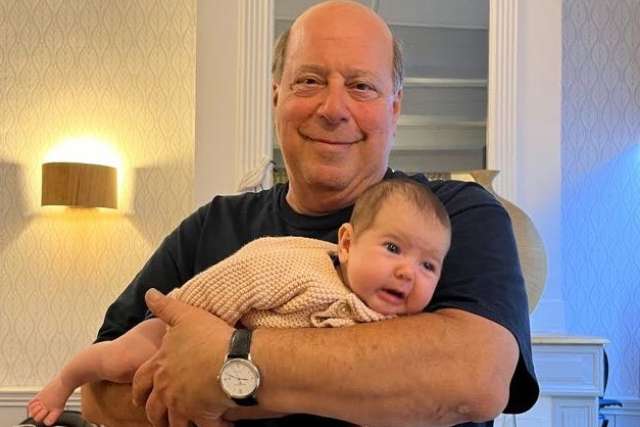After Dan Freeman’s diagnosis of prostate cancer, he feared a cure could be worse than the disease.
He balked when his doctors in the Bay Area proposed surgery or conventional radiation that might result in bladder, bowel or sexual dysfunction.
While researching other options online, he stumbled upon an interview with UCLA Health radiation oncologist Amar Kishan, MD.
At home in San Mateo, Freeman watched Dr. Kishan discuss his use of MRI-guided radiation to reduce side effects. He explained how the highly personalized approach reduces radiation exposure to other organs by more precisely tracking and targeting the prostate gland as it moves within the pelvis.
“I’m very passionate about educating patients on all the types of options they might have,” said Dr. Kishan, a member of the UCLA Health Jonsson Comprehensive Cancer Center and a professor at the David Geffen School of Medicine at UCLA. “We can be grateful that when treating prostate cancer, we can expect a high chance of a cure, so we really want to reduce the side effects.”
Freeman, now 72, traveled to Westwood for the leading-edge treatment that UCLA Health has helped pioneer and research.
“I was so relieved to have found a less invasive approach with far fewer possible side effects,” Freeman said. “And now I’m really interested in having more men be able to take advantage of this.”
A common diagnosis
In early 2022, Freeman learned that he had prostate cancer. He had no symptoms but underwent a biopsy because his prostate-specific antigen (PSA) levels had risen over the previous few years.
Prostate cancer is the second-leading cause of cancer death in American men, behind only lung cancer. About 1 in 44 men will die of the disease, according to the American Cancer Society. However, most men who are diagnosed will survive.
Prostate cancer often progresses very slowly and doesn’t always need treatment, Dr. Kishan said.
“We always hear that prostate cancer can sometimes be overdiagnosed and overtreated,” he said. “Dan had a prostate cancer that was aggressive and needed treatment.”
Freeman’s Bay Area doctors offered him options that sounded bleak. He could undergo a radical prostatectomy to remove the prostate gland and surrounding tissue, which could result in incontinence and erectile dysfunction. Or he could receive traditional radiation that could cause urinary, bowel or sexual side effects.
“I’m 70 and I’m not going to be able to hold my urine very well for the rest of my life, and I’m never going to have sex again – that’s what was going through my mind,” Freeman recalled. “It felt like death either way.”
Once Freeman learned more about his tumors and that his odds of dying of prostate cancer were small, prioritizing quality of life in his treatment plan became even more important.
“I’m more likely to die from something else, like a heart attack,” he said. “After being told that removing my prostate was the gold standard, I felt that there’s got to be someone else out there that’s been working on a less invasive approach.”
After viewing Dr. Kishan’s interview on YouTube, he immediately booked a virtual consultation with him to learn more about MRI-guided high-dose stereotactic body radiotherapy, or SBRT.
Dr. Kishan said a five-day course of SBRT is an effective alternative to lower doses of radiation that are administered for up to 45 days.
“We have learned over the years that prostate cancer may respond better to a higher dose per day,” Dr. Kishan said. “This has led to the study of shorter and shorter courses of radiation.”
UCLA Health has been a leader in the use of SBRT since 2010, and Dr. Kishan led a clinical trial on MRI-guided SBRT using a MRIdian device. Results showed fewer bowel and bladder side effects than for patients who received radiation guided by CT.
Dr. Kishan said while most radiation therapy delivery machines rely on a CT scanner or X-ray to help direct the radiation, the prostate is not easy to view with those methods.
Additionally, he described the prostate gland as a moving target.
“The prostate itself moves quite a bit during the radiation treatment, which means while the patient is lying on the table, the prostate is moving back and forth, up and down and side to side,” Dr. Kishan said.
The small movements occur as the nearby bladder and rectum fill and expand.
“We are talking about motion on the order of millimeters,” Dr. Kishan said. “When we are delivering high dose, precise radiation, every millimeter counts. It’s high value real estate.”
Dr. Kishan noted that unwanted side effects occur from “off target” radiation exposure to healthy organs and tissue near the prostate. Use of the MRI allows doctors to reduce that margin by capturing images four times per second during the procedure.
“We can see in real time where the prostate is and we can therefore track it extremely precisely,” he said. “We can focus the radiation much more closely to the prostate rather than a broader area we had historically used.”
If the prostate moves outside of a specific boundary, the radiation beam will automatically turn off until it moves back into range.
Dr. Kishan said insurance providers typically cover MRI-guided SBRT and the treatment has become standard at UCLA Health.
Undergoing treatment
In June 2022, Freeman traveled to Westwood to undergo five radiation sessions. He also enrolled in Dr. Kishan’s radiogenomics study to evaluate his predisposition to radiation side effects based on a biomarker. A cheek swab of his DNA revealed that he was not at higher risk of side effects from the higher-dose SBRT.
“My main area of research and focus is improving the effectiveness of our treatments and reducing their side effects,” Dr. Kishan said. “Even with the better radiation, some patients might just experience side effects because they’re inherently sensitive to radiation.”
The study hasn’t been released yet, but based on preliminary results UCLA Health patients are offered the cheek swab to help guide their decision-making process.
Freeman, a retired management consultant and travel industry executive with a background in finance, said each radiation session lasted about 45 minutes to account for the times when the machine stopped and waited for his prostate to move into position again.
As he listened to 1960s rock through headphones, he watched a screen that showed the outline of his prostate and the progress of the session.
“When it lined up, I got the radiation,” he said. “Every so often the prostate would move off the line and the radiation would stop. Seeing the progress made the time pass quickly and instilled a belief that the radiation would work.
Life today
After the radiation, he experienced a minor side effect, a greater urgency to urinate several times every night. Prescription medication alleviates much of this issue, Freeman said.
“I have virtually no side effects and little to no adverse effects sexually.”
Freeman and his wife of 39 years, Barbara, recently visited Paris to spend time with their daughter and first grandchild. Their other daughter lives near them. He serves as Finance Committee Chair for the California Civil Grand Jury Association and is an adviser to Houston-based Justice For All Immigrants. He also enjoys golf.
He recently underwent a follow-up MRI, which found no sign of cancer. In general, men older than 60 should have a PSA level of 4 or less. Freeman’s latest PSA was .42.
“His PSA has dropped to a level of an extremely good prognosis and a recurrence would be unexpected,” Dr. Kishan said. “By all metrics there’s no evidence of prostate cancer.”
Freeman said he’s referred other men to UCLA Health after they have been advised to undergo prostate removal.
“There’s usually somebody, somewhere that is doing something cutting-edge, and Dr. Kishan is one of them,” Freeman said.




